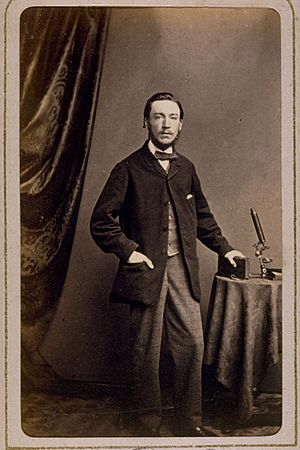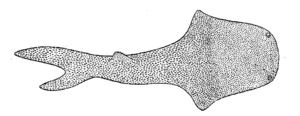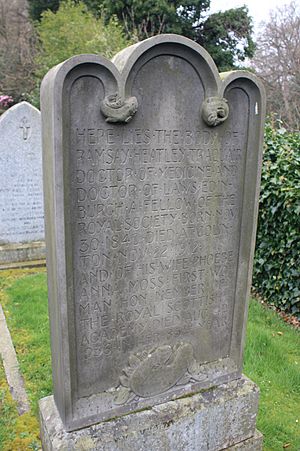Ramsay Traquair facts for kids
Ramsay Heatley Traquair (born July 30, 1840 – died November 22, 1912) was a Scottish scientist. He studied nature and ancient life, becoming a top expert on fossil fish. These are fish that lived long ago and turned into stone.
Even though he trained as a doctor, Ramsay Traquair loved studying fish. He worked as a professor in England and Ireland. Later, he came back to his home in Edinburgh, Scotland. There, he worked at the Museum of Science and Art. For over 30 years, he built an amazing collection of fossil fish.
He wrote many books and papers about ancient fish. His research in Scotland changed how people understood fossil fish. He created new ways to group and name them. He received many awards for his work, like the Lyell Medal and the Royal Medal.
Contents
Early Life and Education
Ramsay Heatley Traquair was born on July 30, 1840. His family lived in a place called Rhynd in Scotland. His father, Rev James Traquair, was a church leader. His mother, Elizabeth, passed away when Ramsay was very young, in 1843.
The family moved to Edinburgh when Ramsay was a baby. He went to school at the Edinburgh Institution. From 1857, he studied medicine at Edinburgh University. He also focused on the parts of fish bodies. In 1862, he earned his medical degree. He even won a gold medal for his paper on flatfish.
Ramsay Traquair's Career Journey
After university, Traquair worked as a demonstrator at Edinburgh University. This was from 1863 to 1866. He then became a professor in England. He taught Natural History at the Royal Agricultural College. But he felt this job kept him from his research.
In 1867, Traquair moved to Dublin, Ireland. He became a Professor of Zoology at the Royal College of Science for Ireland. He worked and taught there for six years. In 1871, he was chosen to be part of the Royal Irish Academy.
On June 5, 1873, he married an artist named Phoebe Anna Moss. She later became known as Phoebe Anna Traquair. They moved to a farm near Edinburgh. They had three children: Ramsay (born 1874), Henry (Harry) Moss (born 1875), and Hilda (born 1879).
That same year, Traquair moved back to Edinburgh. He became the first Keeper of Natural History Collections. This was at the Museum of Science and Art, which is now the Royal Scottish Museum. This new job made sure the museum's collections were separate from the university.
Discovering Ancient Fish
Ramsay Traquair spent 33 years working at the museum in Edinburgh. He built up a huge collection of fossil fish. He found many of these fossils in places like the Dura Den gorge in Fife, Scotland. His collection was considered one of the best in the world.
He studied fossils from ancient rocks like the Old Red Sandstone. He also looked at rocks from the Carboniferous period in Scotland. He classified many types of fossil fish. His work changed earlier ideas by another scientist, Louis Agassiz. Traquair published much of his research in a series of books.
In 1881, Traquair became a Fellow of the Royal Society of London. He also gave lectures at the Natural History Museum in London. He was a 'Swiney Lecturer on Geology' for two five-year periods. He was also a Fellow of the Royal Society of Edinburgh and the Geological Society of London.
Family Life
Ramsay Traquair was married to the artist Phoebe Anna Traquair. They had two sons and one daughter. Their son Ramsay became a famous architect. Their other son, Henry (Harry) Moss, became a well-known eye surgeon in Edinburgh.
Awards and Special Honors
Ramsay Traquair received many awards for his work.
- In 1881, he received an award from the Wollaston Fund.
- In 1901, he was given the Lyell Medal. Both of these were from the Geological Society of London.
- He also won the Neill Prize and the Makdougall-Brisbane Prize from the Royal Society of Edinburgh.
- In 1893, Edinburgh University gave him an honorary law degree.
- In 1907, he received the Royal Medal from the Royal Society. This award was for his important discoveries about fossil fish.
- In 1909, his life and work were featured in the 'Eminent Living Geologists' section of the Geological Magazine.
Later Years and Legacy
Ramsay Traquair retired in 1906. He moved to a place called "The Bush" in Edinburgh. He passed away on November 22, 1912, at 72 years old. His wife and three children survived him.
He is buried in the graveyard at Colinton Parish Church. His wife designed his headstone, and it was carved by Pilkington Jackson. Many newspapers and science journals wrote about his life after he passed away. His wife and the ashes of his son Harry were later buried with him.
Images for kids




